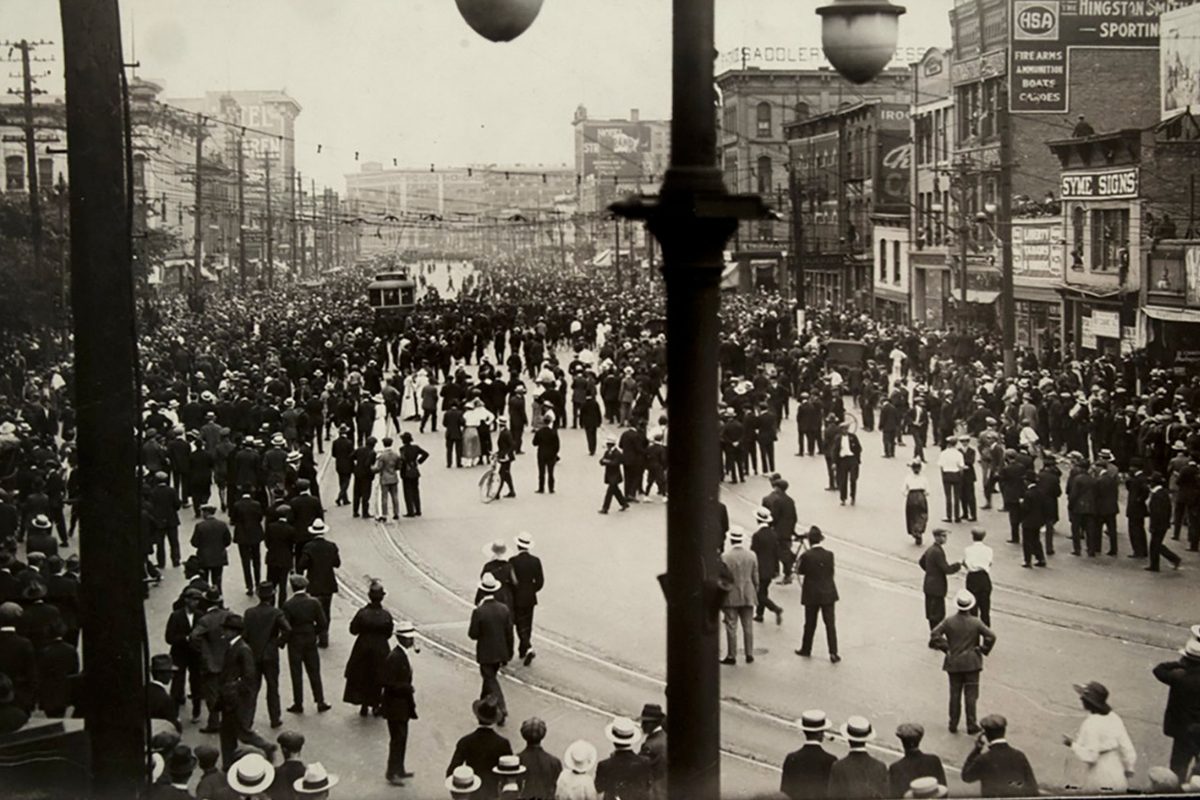
Photo of Main Street in Winnipeg during Bloody Saturday during the Winnipeg General Strike on June 21, 1919 from the Eva Stewart collection with Archives of Manitoba.
Bloody Saturday, a key moment in Winnipeg’s history
Digital archives exhibition provides context for 1919 Winnipeg General Strike
On June 21, 1919, crowds congregated near City Hall for a silent parade in response to the arrest of strike leaders.
They began to gather around noon. Or was it 2:30 p.m.? Or some time in between? A streetcar approached—most likely from the North, though others claimed it came from the South. Crowds charged the streetcar as Mayor Gray read the riot act once, or twice. The Royal Northwest Mounted Police charged three times. Or was it four? Violence quickly erupted as men … or women … or was it teenagers? set a streetcar on fire.
It was Bloody Saturday: a key moment in Winnipeg’s history, in the midst of arguably the most famous strike in Canada’s history. Despite its renown, the documentary legacy of the strike—newspaper articles, photographs, witness accounts, film footage, etc.—still leave many questions about the events unanswered.
New multi-partner digital exhibit marks strike centenary
To mark the 100th anniversary of the Winnipeg General Strike on May 15, the University of Manitoba Libraries is launching a digital exhibit that provides context on the event.
The narratives that survive from 1919 are multifaceted: They change from one account to the next, and are influenced by various memories, biases and motives. Consequently, providing a precise retelling of the strike is a complex and ultimately impossible endeavour.
A contextual approach
The exhibit is not a retelling. The new digital exhibition is a collaboration with multiple libraries, museum and archives, and takes a contextual approach to the six-week struggle that began in response to unresolved strikes by the building trades and metal workers on May 1 and May 2, respectively.
A timeline of the events is provided, from May 15, 1919, until the strike was called off by the Strike Committee on June 26.
It also goes beyond the strike, exploring its origins and aftermath, and also highlights the people who played a role in the events, including past students of the U of M-Strike leader William Ivens, Citizens’ Committee of One Thousand Members Isaac Pitblado and Travers Sweatman, as well as Solomon Moses Almazoff, whose studies at the University were interrupted when he was arrested as a strike leader. In fact, he had little involvement in the strike, but as authorities wanted to blame the strike on so-called “enemy-aliens” and Bolsheviks, Almazoff’s Russian roots made him a good scapegoat.
Finally, the exhibit explores the places that played key roles in the strike: Market Square, City Hall, the Board of Trade building, the Labor Café, Victoria Park, Hell’s Alley, and more.
Alongside the digital exhibit, the website features a listing of primary and secondary sources available locally (in Manitoba), or online to provide the opportunity to dig deeper and think more critically about the strike.
As a collaborative project, the website features digital content from the University of Manitoba Libraries, the City of Winnipeg Archives, the Winnipeg Police Museum, the University of Winnipeg Archives, the Archives of Manitoba, Library and Archives Canada, and the University of Calgary Archives. The City of Winnipeg Archives and the Association for Manitoba Archives further collaborated with the University of Manitoba Libraries to develop the narrative for the exhibit.
The Winnipeg General Strike 1919 Digital Exhibit is available now, with more content to be added as the anniversary of the General Strike on May 15 approaches.
Read more about the strike and other aspects of the exhibition.






